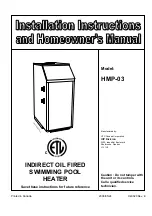
Page 25
ENGLISH
Jandy
®
Pro Series TruClear
™
Chlorine Generating System
|
Installation & Operation Manual
Problem
Possible Cause
Corrective Action
Salt level too high.
Too much salt has been added to pool.
Metal debris caught between plates or
cell plates that may be touching.
Verify salt levels by testing. Using the most
reliable method available i.e. taking sample
to pool dealer before taking any dilution
action. Backwash or partially drain pool
and dilute with fresh water until salinity
returns to 3,000 ppm - 3,500 ppm.
Remove any debris caught between plates
by using a garden hose under moderate
pressure. If plates are loose and touching,
replace the cell.
Strong Chlorine odor.
Presence of excess chloramines
(combined chlorine).
Chlorine is an oxidizer, which means that
organic waste is being removed from the
water into the air. Strong odors are a part
of this process. If these odors persist
longer than 12 hours, take a water
sample to your local pool dealer.
Manually shock the pool
(see Section 4.3).
Cloudy water, slimy
walls of pool.
Combined algae and bacteria growth.
Brush down the affected walls and then
manually shock the pool
(see Section 4.3).
Eye and/or skin
irritation.
Improper water balance.
Balance the water to recommended levels
in Section 4.4.
High chloramine levels
Raise production rate to 100% and run
pump for 24 hours.
DO NOT SWIM DURING THIS TIME
Scale formation on
pool equipment.
High calcium hardness.
Incorrect pH causing minerals to come
out of solution.
Dilute pool with fresh water. Consult your
pool professional regarding use of a
sequestering agent.
Adjust total alkalinity to 80 - 120 ppm
(U.S.) or 100 - 120 ppm (Canada). Then
adjust pH to within the range 7.4 - 7.6 (see
Section 4.4).
NOTE
To clean the deposit (scale) on the cell, see Section 6.3.
















































